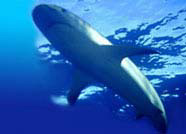


Shark Glossary

 |
 |
 |
|||
| Home | Evolution
| Classification
| Glossary | Biology
| Behavior | Shark
Repellent | Shark
Conservation | Do's &
Don'ts | Did You Know?
Shark Glossary |
 |
||||
|
 Oceanic
Whitetip Shark Oceanic
Whitetip SharkCarcharinus longimanus is a large, thick-bodied, slow-moving shark with very large, paddle-shaped pectoral fins and white tips on its pectoral, and dorsal fins and tail. It is not closely related to the smaller whitetip reef shark. It can grow to be about 13' (4 m) long, but is usually about 10 feet (3 m) long. It is a potentially dangerous predator, very aggressive and eating just about anything. It lives far offshore and in depths up to 500 feet (150 m). They have litters of up to 15 pups (the number of pups increases with the size of the mother) after a 1 year gestation period. It is found in all tropical and subtropical waters. Orectolobiformes A clade of shark that has an anal fin, 5 gill slits, 2 dorsal fins, no fin spines, and the mouth in front of the eyes. These include the carpet sharks: the wobbegong, nurse, bamboosharks, blind, zebra, and whale sharks.
 Orthacanthus OrthacanthusOrthacanthus was an ancient, fresh-water shark that had a long spine growing from the back of its skull. It had a very long dorsal fin, which ran all along the sharks back, giving it an eel-like appearance. Order Xenacanthiformes. Osmosis Osmosis is a process in which water flows across a semi-permeable membrane from an area of higher concentration of water to an area of lower concentration of water, effectively moving to equalize concentrations. In the case of sharks vs. sea water, water flows from the sea water into the even-saltier shark via gill tissues. Oviparous Oviparous animals hatch from eggs. Some sharks, like the Port Jackson shark and the nurse shark, are oviparous. Oviphagous Oviphagous (meaning "egg eating") animals hatch from eggs, but the eggs hatch and the babies develop inside the female's body. There is no placenta to nourish the pups. The pups are cannibalistic; they eat any unfertilized eggs and their siblings. Very few pups in a litter survive until birth. Sand Tiger sharks are oviphagous Ovoviviparous Ovoviviparous animals hatch from eggs, but the eggs hatch and the babies develop inside the female's body. There is no placenta to nourish the pups. Great white sharks are ovoviviparous. Ovoviviparity is now called aplacental viviparity. |
|
||||||||||||
| Sitemap | Reach To Us | Jimtrade - Business Directory of India | |||||||||||||